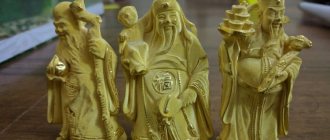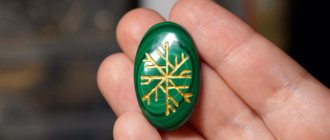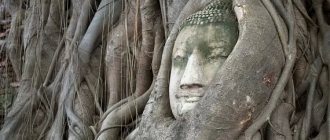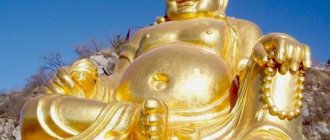Seven gods of happiness, mystical Japan
Japan. A country of high technology, order, discipline and...ancient beliefs and traditions. Today is a story about deities - the seven gods of happiness. Their images: netsuke, engravings, street statues are found literally at every step in Japan; for many centuries, each of the Seven has been worshiped by a huge number of people.
On New Year's Eve, when all of Japan decorates their homes for happiness and good fortune, a magical treasure ship (takarabune) enters the port and lands the Shichifukujin - the seven gods of happiness - ashore. They are ready to give happiness to anyone they meet and help even with the most ordinary and everyday request. It is not so easy to meet them, because there are many who want to find happiness. The ship itself sails from a better world that lies on the other side of the sea. Takarabune - a treasure ship - is loaded with gold and rice, wisdom and longevity, health, and good luck. On the sail of the ship is the Chinese character “baku”, which denotes a mythical animal that averts nightmares.
The gods of fortune appeared in Japan, in the ancient city of Kyoto in the 14th century and they are not all local residents of Japan. The gods came from different countries: China, India and only one of them was Japanese.
The Japanese, like all people on our planet, tried to give an answer to what seemed to be such a simple, but such an insoluble question: “what is happiness.” And so, in the 17th century, the Japanese military ruler Tokugawa Ieyasu, having destroyed all his enemies, having come to the coveted power, having received everything that a mere mortal could dream of, instructed his spiritual mentor, the monk Tenkai, to “catch happiness by the tail,” namely , define this feeling. Tenkai formulated seven types of happiness: justice, material well-being, benevolent attitude, generosity, fame, long life, dignity . Each of the magnificent Seven was assigned its own role, each was assigned its own type of happiness.
Why seven? The Japanese, like much of the rest of the world, consider the number seven to be magical. In Japanese folklore, seven is a lucky number. The “seven Buddhist treasures” and the seven gods of luck are known. Japanese Buddhists believe that reincarnation occurs only seven times, and seven weeks of mourning should be observed after the death of a loved one.
In Japan, there are seven magical spring herbs that are added to rice porridge: Japanese parsley, shepherd's purse, cucumber, chickweed, chickweed, turnip, and rhizome. Spring herbs protect against diseases and expel evil from the body.
Magical autumn herbs, seven in number: Japanese clover, brisket, patrinia, Chinese sapling, cloves, sugar cane, arrowroot. These herbs are inedible and are used to decorate houses during the September full moon holiday.
Now let's take a closer look at each of the seven gods of happiness!
Ebisu. God of happiness and good luck.
He is the only one of the seven gods who is of Japanese origin. The first-born of Ebisu's parents was born without bones due to the parents' incomplete observance of the wedding ritual. At birth he was named Hirako - tadpole. Before his third birthday, Hirako was carried out to sea on a reed boat, which, after long wanderings on the waves, washed up on the shore of Hokkaido, where he was picked up by the Ainu Ebisu Saburo. Overcoming many difficulties, Hirako grew legs and arms and at the age of three turned into the god Ebisu. He is a little deaf, but cheerful and friendly, which is why he is often called the laughing god. Depicted wearing a high hat with the sacred Tai bream. It is very difficult to catch a Tai fish with your bare hands in clear heavenly water; it is also difficult to achieve peace of mind and enlightenment. At the end of March and beginning of April, these bream acquire a bright red color and go to the shores of Japan to spawn. Since cherry blossoms bloom at this time, sea bream in breeding plumage is considered the king of fish in Japan.
Ebisu was originally worshiped by fishermen and residents of fishing villages. They prayed to God for an abundance of fish in the sea and calm winds, and good luck in sailing. And to this day, fishermen set up a small shrine to him at the entrance to the bay or on the top of the cape, cut the first catch into sashimi and present it to Ebisu. Over time, this character became the deity of trade in Japan. The fish in Ebisu's hands began to be perceived as a symbolic reward for honesty in trading matters.
Ebisu was also the patron of various crafts, so netsuke carvers sometimes depicted him as a master of a certain profession, for example, a cicada catcher. In rural areas he is revered as the god of rice fields. Ebisu helps sailors in sailing, merchants in trade, and housewives in the kitchen.
The twentieth day of each month is considered Ebisu Day in Japan, and from January 9 to 11, Toka Ebisu is held - a holiday in his honor. The main event of the holiday is the ceremonial parade. A huge image of Ebisu is carried on a stretcher, followed by a motley crowd of musicians, geishas, celebrities and "luck girls" chosen from the finest beauties.
Local shops and restaurants offer special discounts at this time: since Ebisu personifies honest business dealings, merchants try to “pray” the thirst for profit by apologizing to their patron.
At Nishinomiya Shrine (Hyogo Prefecture), a special ceremony is held on the tenth day of the first moon (now January 10). The ceremony is called "Tooka Ebisu", and it begins with the ritual of opening the gates at 6 am. The first three people to appear before the Ebisu Shrine (which is 230 meters from the gate) will become “people of fortune” and will be especially blessed.
And yes, you have to fight for luck!
Daikoku (Daikoku-ten) is the patron saint of peasants, the god of wealth, brings wealth and prosperity, full bags of rice, keeper of the kitchen and giver of food.
The figurine of Daikoku is easy to recognize: good-natured, in peasant clothes, with a bag, a sacred mallet and a rat. The bag contains wealth, but the rat will only appear in a rich house: in a poor one it simply has nothing to eat. The bag itself is filled with magical rice, and when the rat gnaws holes in it, the rice spills right into your hands. Daikoku dances and taps the sacred mallet, that is, forges happiness: with each blow there is more happiness and prosperity in the world. So let him knock to his heart's content, because when Daikoku shakes his mallet, coins miraculously fall out of the air. Daikokuten is of Indian origin, but there it is a wrathful deity, guardian of faith, six-armed and three-faced. And Daikokuten reminds us of Santa Claus, with a magical wooden hammer in his hand, which allows him not only to break grains of rice, but also to work miracles. Daikoku was featured on the first Japanese one-yen banknotes, issued in 1885.
The only lady, Benzaiten. Goddess of happiness, love, beauty and art.
In Indian mythology, she was the deity of rivers (“Saraswati” means “flowing water” in Sanskrit), and is therefore associated with everything that “flows”: music, eloquence, literature. In her hands is a Japanese lute - a biwa. Benten came to Japan, just like other Indians, along with Buddhism and soon became a favorite. Near Kamakura there is the famous island of Enoshima. Legend has it that once upon a time there lived in a cave a terrible dragon that swallowed children from a nearby village.
In the 6th century, Benzaiten came to Japanese soil to protect people from a terrible monster. Hanging in a cloud above the cave, it caused a powerful earthquake. After that, she entered the dwelling of the frightened dragon and... married him. Love transformed the dragon: he became obedient and radically changed his behavior. In memory of this event, the island of Enoshima rose from the sea. It rises like an amazing rock above the surrounding sandy shallows. Here, in the middle of the sea, is the main sanctuary of the goddess.
Water always splashes next to the figure of the goddess, and you can often find a well in temples - a white snake lives there, which is a harbinger of good luck when it comes in a dream.
Although Benzaitenen symbolizes friendliness, she is also known to be a very jealous goddess. To depict jealousy, white snakes are sometimes painted that encircle the goddess. In former times, musicians who played the biwa preferred not to marry because they were afraid that the goddess would become jealous and deprive them of their ability to play.
Those families who wanted to have beautiful daughters also prayed to Benten, but the husband and wife had to read the prayers separately and never do this with each other. There was a belief that if a couple prayed to this goddess together, they would be destined to separate.
However, despite her jealousy, the goddess often showed sympathy. She is believed to have helped middle-aged, childless couples conceive as an answer to their prayers.
Nowadays, Benzaiten lovers write wishes on such signs with a love heart.
The bald monk, the cheerful Hotei-osyo is the god of abundance, the embodiment of happiness and carefreeness. It is easily recognized by its huge womb. For the peoples of the East, the belly is the refuge of the soul, and they clearly associate the fat man who came from China with spiritual breadth and generosity.
All the figurines of the Laughing Buddha, as Hotei is also commonly called, are similar to each other: a bald, short, pot-bellied man with a huge bag. In the bag, of course, there is money: silver and gold coins, precious stones and jewelry. But there is another version about the contents of the magic bag: it contains all human bitterness and sorrow. Hotei makes sure that the bag is always tightly tied, protecting people from disasters and problems.
Hotei figurines are very popular for attracting good luck and big earnings to your home. It is better to choose a golden or white figurine: the deity is capricious and has its own preferences. A cheerful god can help lonely people find a family: to do this, you need to buy a figurine in which Hotei is surrounded by children.
Activating the talisman is very simple: you just need to rub the figurine on the belly. In ancient times, the Japanese believed that if you rub Hotei’s tummy three hundred times while thinking about what you want, your wish will definitely come true!
There are many stories and legends about Hotei. One of them says that the merry fellow Hotei used to be a very handsome man and all the women who ever saw him fell in love with him. And in order not to break fragile women’s hearts, Hotei decided to become small and fat!
Another legend says that in the 10th century. The well-fed monk Qi Qi walked around the villages of China. As a wandering monk, he sometimes slept outside in the snow and blizzard, and his holiness prevented him from freezing. However, he often indulged his human weaknesses and gladly consumed meat and fish forbidden to the clergy. When passers-by asked what he was carrying in his bag over his shoulders, Qi Ci answered that he had collected all the sorrows of the world in it, and now everyone could only laugh! Where this mysterious wanderer appeared, health and good luck came to people. His jokes could make everyone laugh, rich and poor, even seriously ill people! It was believed that the monk distributed food and benefits to the poor from his never-ending bag.
Later, the mysterious contents of his bag became associated with Ta-Khun - the Great Emptiness, the progenitor of the entire surrounding world. The monk’s belly was no longer perceived simply as a symbol of the well-being and breadth of his soul, but also as an abyss in which all the suffering and sorrow of the world disappear.
Hottei is especially popular among bartenders and restaurateurs; the god of abundance inspires people to eat and drink a lot.
Fukurokuju, god of wealth, happiness and longevity. Gives wisdom, intuition, helps to make a scientific career.
His name consists of three hieroglyphs: “fuku” - happiness, “roku” - reward for work, “ju” - longevity.
Country of origin China. He can be recognized by his unusually high forehead and long white beard. In his hand he holds a staff, to which is attached a scroll with sutras. They say that this scroll contains all the wisdom of the world. Among his seven comrades, he is the only one who is able to resurrect from the dead. He lives in a palace, which is surrounded by a magical garden where the herb of immortality grows. In addition, he can do without water and without food. He loves to play chess. The following legend is connected with this: one day a farmer, returning home, saw two old men playing chess. The farmer stopped, watching the game, and it seemed to him that after each move the beards of the opponents became longer and longer. The match was long, and the bearded, long-headed old man treated the peasant to strange-tasting fruits to satisfy his hunger. A long time passed when the farmer finally noticed that the day was over and politely said goodbye to the players. Rushing home, he discovered that the house no longer existed. The stunned farmer eventually learned that 200 years had passed while he had been watching the chess game.
After living for many years, Fukuruju turned into a turtle, a symbol of immortality and the wisdom of the Universe.
Fukuroju shapeshifting figurines are very popular in Japan: when looking directly at, the human appearance of the deity is revealed, but if the figurine is placed on its stomach, a turtle appearance is revealed. His figures help to quickly make important and wise decisions, and help students remember science well!
Jurojin (“long-lived old man”) is the god of longevity and immortality. This kanji name literally translates to "Man Who Lives Long." He is considered the reincarnation of the Star God of Longevity, who monitors life on Earth and knows how long someone is allotted to live: he has a scroll, and the life spans of all creatures living on our planet are written there.
He is called the patron saint of scientists and scientific success. Jurojin is depicted with a staff made of peach wood - the Rod of Ruyi. This is a wand of wish fulfillment and happy omens. From Chinese, “ruyi” is translated as “whatever you wish.” Jurojin is dressed in a cloak and cap of a scientist and teacher. The god is bald, but has a gorgeous beard - its length symbolizes the number of years he has lived.
The god is often accompanied by a deer or turtle; according to legend, this deer is at least 1500 years old. According to legend, if you eat the meat of this deer, a person can live up to 2000 years.
Despite his advanced age, he is known as a lover of female company, and is not averse to drinking sake - after all, true wisdom cannot be achieved by avoiding fun, while always remaining serious! God also has a magical musical instrument, and when it is played, all good wishes come true, and people around become rejuvenated.
Jurojin and Fukurojin are so similar that they are sometimes considered different spirits in the body of one elder.
They say that one day Jurojin was invited to a holiday at the Emperor’s court, and there he began to boast that he could drink as much wine as he wanted. According to this Chinese legend, he then drank one koku (160 liters) of rice wine (sake), but was completely sober when he appeared before the Emperor the next morning expressing words of gratitude for a pleasant evening. He predicted a long and prosperous reign for the Emperor and then disappeared into a white fog (perhaps it was wine fumes?)
Bishamonten is the god of wealth and treasures, guardian of the North, punishes Evil, cures diseases, expels demons. Symbolizes dignity. His middle name is Tamonten - this is his name as one of the four heavenly guardians. He is strong and merciful. And in Sanskrit his name means God who hears everything.
Bishamonten is the patron saint of warriors, and therefore is dressed in military armor and holds a spear in his hand. In his other hand he holds a small pagoda. The pagoda is a treasure tower from which he gives wealth to all good people. But, on occasion, it can take your wealth back, so you must always remain good!
God Bishamon was borrowed from India, where he was the god of war or in other words, the warrior God who protected and guarded the heavens. There is a beautiful legend: more than 6 million years ago, the formidable King of the Conquerors of Evil descended from Venus to Earth, on the top of a mountain. He came down for a reason, but with a great mission to save humanity. For millions of years, his great spirit lived on the top of the mountain and ruled people's lives. And so, in 770, the monk Gantei saw a white horse on the slope of that mountain and went after it. The horse led the monk to a sacred place, where enlightenment descended on the monk and he became the reincarnation of Bishamon, the Guardian of the Northern Limits of Paradise.
In Japan, it is believed that Bishamon brings people wealth and early luck, being officially the god of wealth. The warrior god fights on the side of good, destroying evil in the world, giving happiness to everyone who asks. It is believed that if you keep the Bishamon figurine with you or in a visible place, then financial improvements will come.
His animal is a dove. Because Bishamonten is the patron saint of warriors, he is often associated with the Shinto deity Hachiman, the god of war. Tsurugaoka Hachimangu is an ancient temple where warriors asked for good luck in battle, the main shrine of Bishamon.
Since then, a huge number of pigeons have lived near the temple complex.
And today we can see flocks of pigeons on the roofs of temple buildings, and the Tsurugaoka Hachimangu complex itself is the main purpose of pilgrimage to these lands.
In the 14th century the cult of the seven gods reached its peak. This was especially true in the capital of Japan, Edo, where there was a custom of annual pilgrimage to temples dedicated to one or another god of happiness. This pilgrimage took place in the first month of every year. And now those who urgently need divine support or who want to escape from the daily whirlwind and, under the shadow of sacred temples, indulge in unhurried thoughts about the eternal, go on a small journey - a pilgrimage to temples associated with the gods of luck. The temples are located close to each other so that believers can visit all seven temples in one night. There are several such “ring routes” in Tokyo. The most popular of them runs along the banks of the Sumida River and is approximately three kilometers long. There are signs along the entire path, so it is difficult even for a stranger to lose his way. You can go the whole way alone, but there is also the opportunity to join a group of pilgrims. In each of the temples, a visitor can put a colorful stamp on a specially purchased card, which thus itself becomes a talisman and a “guarantee” that luck will not abandon its owner. Pilgrims buy small figurines of the seven gods in the temples - separately or all together on a small treasure ship - Takarabune. After all, it is loaded not only with gold and rice, but also with wisdom, longevity, health, and good luck.
Most often, temple visitors buy the ship depicted in the engraving.
This drawing should be placed under your pillow on New Year's Eve. The Japanese are confident that the first dream in the New Year is prophetic and determines fate for the whole year. It is best if in a dream you see Mount Fuji, hawks or... eggplants.
Noble Mount Fuji, a smart and strong bird, but an eggplant? This came from a statement by Shogun Tokugawa: when he learned about the cost of the first eggplants of the season, he was very surprised and said that only Mount Fuji and Mount Ashitaka (“taka” - hawk) were more expensive (higher) in his province. It is also said that Mount Fuji, falconry and the first eggplant of the season were the shogun's favorite things. So a dream about an eggplant is perceived as a clear forecast of a happy year.
Those who are unlucky with their dreams, who dream of something unpleasant, can get rid of the obsession by throwing a leaf with the image of Takarabune into a stream or river in the morning. Then a bad dream - a harbinger of bad luck - will be carried away by the waves far out to sea.
Team assembled
7 gods of happiness in a boat
However, the deities manifest themselves most actively when they are together in their boat. In Japan, there is a term "okimono", literally this word means a thing for putting on display. This is exactly what you should do with this powerful talisman. You need to put it in the most visible and honorable place in the house, watch it, examine it, pay attention in every possible way, wipe it from dust and dirt in a timely manner, and take care of it. This should not just become a habit, but become a mandatory ritual, performed with good intentions and full awareness of what you are doing. In this case, the gods will bestow on you all the best qualities for which they are responsible. Gradually, with proper treatment, they will come to you, improve the quality of life, bring happiness, material wealth, wisdom, longevity, good health, and protect your home and family from bad weather and troubles.
Fukurokujin (Fukurokuju)
God of longevity and wisdom. The name comes from fuku - wealth, roku - career, happiness, ju - longevity. He is depicted as a very old man with an elongated head (phallic symbol).
Origin
Fukurokuju has Chinese history. According to one version, a certain Fukurokuju dissuaded the Emperor of China (Liang dynasty, Emperor Wu, 5th-6th century) from recruiting young men from one of the villages, which earned him the gratitude and veneration of its inhabitants. Since then, his image has acquired the ability to perform miracles and bring prosperity.
According to Chinese traditions, Fukurokuju is the incarnation of the South Pole Star.
It is generally accepted that the prototype of Fukurokuju are the gods of Taoism - Shousin (the Elder of the South Pole, as well as the faithful companions of Shaoxing - Fuxing - the god of happiness and Luxing - the god of career.
This is confirmed by the spelling of the name. In Japan, Fukurokuju is written in three hieroglyphs: fuku - abundance, wealth (Fushin also from Japanese fuku, roku - translated as happiness (Lusin in Japan - rank, career), ju - longevity (Shousin, Lusin and Fushin from Chinese - triad of stellar spirits).
Another legend
He loves to play chess. The following legend is connected with this: one day a farmer, returning home, saw two old men playing chess. The farmer stopped, watching the game, and it seemed to him that after each move the beards of the opponents became longer and longer.
The match was long, and the bearded, long-headed old man treated the peasant to strange-tasting fruits to satisfy his hunger. A long time passed when the farmer finally noticed that the day was over and politely said goodbye to the players.
Rushing home, he discovered that the house no longer existed. The stunned farmer eventually learned that 200 years had passed while he had been watching the chess game.
What does it look like
A benevolent and respectable old man with a long white beard and an incredibly elongated head (the main feature), signifying wisdom, is usually dressed in Chinese clothing, which is often depicted in netsuke as a tortoise shell.
Sometimes Fukurokuju holds a staff, a fan and a scroll in which all the wisdom of the world is written (sutras - sacred texts).
Sometimes depicted with a child or children. Nearby are a shik deer (1500 years old), a long-tailed turtle (minogame) or a tsuru crane. All accompanying Fukurokuju in Japan are also symbols of longevity. Fukurokuju is often depicted in pairs with Jurojin and Daikoku, sometimes with the goddess of happiness Okame.
He is small in stature and has a long gray beard. Can be depicted with a fan in his hands and a scroll containing all the records of the wisdom of the world. Fukurokujin is able to give real longevity and true prosperity. They give a figurine of God to mature people with wishes of prosperity and long life. Also perfect for thinkers, scientists and those who are busy implementing new plans.
Fukurokuju's tall head embodies the exceptional wisdom he has gleaned over the long years of his life. However, she is clearly phallic in shape, which brings to mind Fukurokuju's friendship with the voluptuous goddess Okame.
Who do they give it to?
Usually Fukurokuju is intended as a gift to a person who has reached adulthood, who is wished for prosperity and long-term happiness.
Most often, watchmakers, chess players, scientists, thinkers, as well as everyone who is busy implementing something new, for example, builders of a new house.
Fukurokuju appreciates the art of wise contemplation, although he is not averse to humor and is not offended by good-natured banter. Figures of Jurojin and Fukurokuju are capable of attracting the patronage of the powers that be to the owner, and also serve as a guarantee of good health and longevity.
Bishamon (Tamonten)
Initially, he did not play the role of the god of happiness, he was responsible for war and warriors. That is why he is still depicted with a sword in his hands or a spear and wearing full samurai armor. He was assigned to be one of the four protectors of Buddhist temples.
Origin
Bishamon-ten (bishamon) - Tamon-ten - phonetic calque from Sanskrit of the Hindu god, heavenly messenger Vaishravana, in Buddhism - Tamon-ten (mythologically protects the places where Buddha preaches), - a warrior god.
He fights on the side of good, but since there is still enough evil, he has to fight a lot. Bishamonten lives on the slope of Mount Meru, which is crossed by the axis of the world. He lives on its northern slope and is called the guardian of the North (guardian of the lokapala).
According to more ancient legends, for the first time the figurine of Bishamon-ten mystically came from one wise hermit who lived on Mount Shigi, bringing him a well-deserved reward for his righteousness. Later the war passed into the hands of the valiant Kusunoki Masashige, who named his son Bishamon-ten. Since the 15th century in Japan, it was customary to install the image of Bishamon-ten on the kamidana (stick for the gods) to quickly achieve happiness.
What does it look like
Bishamon-ten, usually in armor and a helmet, holds a sword or spear in one hand, sometimes a trident, and a small pagoda (hoto) in the other. He protects the sacred pagoda and distributes treasures from it to the worthy. Bishamon-ten is often identified with the Shinto god of war Hachiman (Hachiman), whose messenger was once a dove, which is now also Bishamon-ten's bird.
There is one secret. In practice, it is known that there are not many good people in the world and Bishamon can destroy his gifts. He is not only a warrior, but also the patron of the military, lawyers and doctors. They give the figurine to people of relevant professions with wishes of prosperity and happiness.
He was especially revered during the Heian period (794 -1185), when there were wars for the development of Honshu, the largest island in the north of the country. In the old days, this god was often identified with another warrior - Hachiman. In the Tsurugaoka temple complex dedicated to the latter, where the monks prayed for victory in the upcoming battles, doves always sat on the roofs, serving as messengers of the divine will.
Later, these same birds became Bishamonten's messengers. A miniature figurine of a warrior god provides invaluable assistance to its owner, defending justice and attracting victory in the most difficult “battles.”
To whom to give
Bishamon-ten brings justice, good luck and happiness. Patronizes soldiers, doctors and priests. They give a figurine of Bishamonten with wishes of financial prosperity and happiness.
Jurojin
Origin
Most of the legends about Jurojin are similar to the origin of Fukurokuju, the appearance and attributes are also the same, with the exception of the shape of an elongated bald head. Jurojin has a normal skull shape and is often covered with a cap. According to his divine purpose, Dryurojin is the god of longevity and respect for old age.
The status of the talisman of the god of happiness came from his ability to give longevity. In this regard, he is usually depicted as an old man with a long white beard. His head is covered with a cap, which is more suitable for a scientist. In his hands he carries a shaku staff, which has a scroll of wisdom attached to the top. According to legend, it records how long each living creature is given to live on earth.
Other beliefs say that the scroll contains the secret of longevity and a happy life. Usually his companions include a turtle, crane or deer. These creatures are known in the east as symbols of longevity. Interestingly, Jurojin is sometimes depicted drinking sake. At the same time, it can be a talisman that protects travelers.
Source: www.domduha.ru
Ebisu
God of hard work and luck. Patronizes workers of various professions. Usually depicted with a fishing rod in his hands or a tai fish (carp).
It is usually pressed to the side or located behind the back. In a number of variations, the bream ended up under the god's arm, symbolizing his constant companion - luck.
By the way, bream was revered by the Japanese as the main fish among all marine life.
Origin
The first sources of mention of Ebisu belong to the 8th century. Born from Izanagi-no-Mikoro and Izanami-no-Mikoto, the baby had a birth injury - lack of bones, due to the mother’s improper observance of wedding rituals (allegedly, during the first intercourse, the wife was the first to utter joyful words - which was a violation).
To save his life, he was released into the ocean. Later, having matured, he climbed ashore and began to live among people.
Another legend about Ebisu
Ebisu was the son of the gods, the ancestors of the Japanese islands. He was born handicapped, without arms, without legs, and generally without bones. His name was Hiruko no Mikoto (or Hirako), which meant “tadpole.”
At a very early age (legend says that he was not yet three years old), he was carried out to sea on a reed boat (according to another version, his parents themselves let him go, believing that it would be better for him this way).
After long wanderings and overcoming many difficulties, Hiruko did not die, he remained alive, and his boat washed up on the shore of the island of Hokkaido. There he was picked up by an Ebisu fisherman named Ebisu Saburo. He fell in love with the little “tadpole” as his own son, raised and educated him.
At the age of 3, the boy grew arms and legs. Hiruko became a real full-fledged deity with the new name Ebisu.
And he began to help people. Especially fishermen and artisans.
When sailing, Ebisu protects fishermen from bad weather and, with his favor, gives a good catch. Ebisu is considered the god of hard work and helps only those who try to achieve everything through their own efforts. In rural areas, it helps people grow rice and protects them from drought.
What does it look like
Sometimes he is depicted as a master of a certain craft. Ebisu is considered semi-deaf from birth, so he always smiles or laughs.
In the plant world, the symbol of Ebisu is bamboo. Together with Daikoku (according to some sources, Daikoku is Ebisu’s father), Ebisu is considered the patron of trade, crafts, and at home, the keeper of the hearth and an assistant in the kitchen. Sometimes Fukurokujin is added to Daikoku and Ebisu, who is the third god of luck.
In March-April, schools of bream moved to the coast to spawn, where fishermen were eagerly waiting for them, and for this period Ebisu became the undisputed favorite among the “lucky seven”. The twentieth day of each month is considered Ebisu Day in Japan, and from January 9 to 11, Toka Ebisu is held - a holiday in his honor. Having become a popular talisman, Ebisu guarantees his fans good luck in business, self-confidence and inexhaustible optimism.
To whom to give
The figurine is given to fishermen for a favorable catch, small traders, as well as artisans. And in Japan, every 20th day of the month is called Ebisu Day.
It protects the house from fire and burglars. Together with Daikoku, they patronize any crafts and trade, and at home they are the guardians of the hearth and invisible assistants in household chores and in the kitchen.
Sometimes Fukurokujin is added to them and together they form a tandem of good luck.
Source: 1fenshui.ru
Benten (Benzaiten)
The only female deity among the seven gods is the ruler of the waters, Benzaiten, who protects from disasters and shocks. It promotes the manifestation of talents, teaches eloquence, patronizes dancers, singers and poets, and brings spiritual and physical harmony.
Origin
Benzaiten (Benten) is the only female image among the seven gods of happiness. Goddess of longevity, fertility, water, music, art, eloquence, protects from natural disasters. Now more details.
According to legend, Benzaiten was able to defeat a terrible dragon that devoured children. Having caused an earthquake, she destroyed the cave in which the dragon lived, charmed him and married him, thereby stopping his outrages.
8According to other legends, the dragon turned into a white snake with the head of a monk and became tame, and Bendzaiten became a protector from snakes. But in Japan there is also a common noun for her - when they talk about female beauty as something insidious or useless, a woman is called Benzaiten. In addition to being purely Japanese in origin, like almost all of the seven gods, Benzaiten has another history related to Vedic origins.
The prototype of Benzaiten are three Hindu goddesses: Saraswati, who, being the goddess of wisdom, passed on her ability to speak, Maharshi and Lakshmi.
From pre-Buddhist legends, it is believed that she adopted the gift from the mistress of water, the White Snake. The smoothness and musicality of Bendzaiten's speech is like the flow of water. Her appearance as a goddess owes more to the female form of Bishamonten (Kichijōten), who is considered the incarnation of Benzaiten.
What does it look like
Benzaiten is often depicted playing the biwa, a Japanese mandolin or sacred lute. Therefore, her figurine will be useful to people of art - musicians, artists, writers. She is always ready to give inspiration and help make beautiful fantasies come true.
This deity is often depicted with an uchide no kozushi - a magic mallet. Each of her blows fulfills a wish made by the children. When Daikoku shakes his mallet, coins miraculously fall out of thin air.
Some Japanese believe that if you knock on the ground three times with the symbolic Daikoku mallet and make a wish, it will certainly come true.
To whom to give
In people of creative professions, Benzaiten inspires and imparts abilities in music, literature and painting. As a gift, it protects against natural disasters and promotes longevity and correction of tongue-tiedness.
The history of the 7 gods
The roots of the formation of this seven gods go back to China, in the 3rd century AD. It is generally accepted that the prototype of the gods in the current perception are the seven sages from the bamboo grove (Zhu-lin-qi-xian) - Yuan Xian, Xiang Xiu, Ji Kang, Yuan Ji, Wang Rong, Shan Tao and Liu Ling.
According to other sources, eight immortals or eight sages were taken as a basis from the mythology of Taoism, who, following the path of Tao, gained immortality and bliss. The path of the seven gods of happiness Shichifukujin has a long history. In Japan, the ancient Buddhist sutra “Ninno hannya kyo” is well known, in which it is written “seven misfortunes will immediately disappear, and seven blessings will immediately appear.”
Under this influence, the idea of the seven gods of happiness was formed. Next, they tried to determine seven types of happiness artificially, by order of the Emperor of Japan. The Buddhist monk Tenkai (Jigen Daishi), known for his philosophical mindset, compared the seven blessings of the sutra with the seven gods and suggested the following types of happiness: longevity, material well-being, contentment, wisdom, fame, honesty and courage.
However, folk art intervened in this process and such laconic formulations regarding the seven types of happiness gradually changed, as did the gods to whom certain benefactors were attributed.
Japanese Shintoism is very loyal to other religions, so it is not surprising that the seven gods of happiness placed in Takarabune's boat (see below) were derived from other beliefs, with the exception of Ebisu, the only one of the seven who is a Japanese god. Of the thousands of gods worshiped in Japan, the place of the seven gods of happiness was taken by one or the other. From the 18th century to the present time, the following gods are considered to be the seven gods of happiness.
Takarabune - Treasure Ship, on which the seven gods of happiness sailed from China to Japan. It is generally accepted that a magic ship is always on its way to another, mysterious and happy world. In Japan, figurines of a magical ship are given as gifts for the New Year with wishes of happiness.
Later, all kinds of amulets and talismans are placed in the boat. Children put it under their pillow on New Year's Eve, and the wishes the child makes come true. Since the 15th century, the seven gods of happiness have been depicted in Takarabune. In Japan, it is customary to give the seven gods of happiness in the first month of the year.
Source: www.domduha.ru
Hotei
There is no god of happiness more cheerful and cheerful than this carefree fat man with a wide smile. In his hand he has an ordinary bag, from which he is able to endow every person with real wealth.
He is one of the seven gods of happiness with full right, since he can make everyone happy who seeks his protection. It is interesting that this is the only one among the seven gods who had his real life incarnation.
Origin
Hotei is credited with the appearance of a real prototype - the wandering monk Qi Qi, who brought prosperity and good luck with him. Subsequently, the visual image of Hotei was taken from this monk. Although the monk was Chinese, Hotei is of more Japanese origin. The name Hotei in Japan is translated as a canvas bag (Ho Tei), since he always traveled with such a bag. From this bag he distributed to people everything they needed.
To the question - what's in the bag? he answered - the whole world is there.
Later, the contents of his bag came to be considered the Great Emptiness (Ta-Khun), which represents the nothingness from which the great everything was born. After the death of the monk, Hotei began to be considered the eighth incarnation of the Buddha, Maitreya Buddha. In Western culture, Hotei is called the laughing Buddha.
According to the canons of Buddhism itself, Buddha Maitreya is a bodhisattva of the ninth level, who will be born as Buddha Manushi 5000 years after the death of the great Shakyamuni Gautama, whose arrival will be the achievement of world harmony.
Now he lives in the heavenly country of Tushita (Garden of Joy) and, according to Japanese legend, in the form of Hotei he descends to people to please them. Canonized as the god of carefree and happiness in Japan in the 17th century.
https://www.youtube.com/watch?v=fneGP0Bav2Q
What does it look like
Hotei is depicted with a canvas bag, with a staff, sometimes holding a gold bar, a pearl or coins. Sometimes with children. Hotei with a pearl represents wisdom. Okimono Hotei is depicted with magic mushrooms. A sitting Hotei is a female talisman, a standing one is a male talisman. The only mortal god among the seven gods of happiness.
Hotei is traditionally depicted with elongated earlobes and a large belly - the embodiment of the life-giving energy of qi.
In Japan there is a belief: any wish will come true if you stroke a Hotei figurine on the stomach. Such a talisman is designed to relieve financial difficulties and give material well-being. It makes spouses happy, and ensures academic success and harmonious development for children.
Usually it is given to close friends to wish all sorts of blessings, abundance and fulfillment of desires. As a talisman, it is given to young children. Our older generation remembers the little smoker - this is a manju-netsuke, even with a pipe.
The smoke released by Hotei forms a specific hieroglyph (kotobuki), which means a wish for longevity and prosperity. In mythology there is a belief: if you rub Hotei on the stomach 300 times and at the same time think about your desire, then your desire will come true. A figurine of Hotei is always placed in a visible place indoors.
Activation of the talisman
Hotei figurines are very popular for attracting good luck and big earnings to your home. It is better to choose a golden or white figurine: the deity is capricious and has its own preferences. A cheerful god can help lonely people find a family: to do this, you need to buy a figurine in which Hotei is surrounded by children.
Activating the talisman is very simple: you just need to rub the figurine on the belly. In ancient times, the Japanese believed that if you rub Hotei’s tummy three hundred times while thinking about what you want, your wish will definitely come true!
Source: mlady.org
Daikoku
Direct patron of wealth and keeper of the hearth.
Origin
Bring the beauty of your soul to perfection, then wealth and luck will flow to you, and you will only have to taste their fruits, - a phrase spoken by Lao Tzu is embroidered on the Daikoku bag and personifies the essence of this god. The prototype of Daikoku came from Buddhism in the form of Mahakala, who was worshiped as the god of wealth and the guardian of faith (guardian and protector of the teachings of the Buddha).
Some associate it with Shiva. But the three-headed and six-armed god Mahakala in this image did not take root in Japan and received a traditional Indian image: in trousers, a hunting suit and a hat with a twisted brim or a peasant hood.
A benevolent fat man with huge ears, a beard or mustache - sheer benevolence and willingness to accept requests. There is a Japanese analogue to Daikoku in Shinto - the deity Okuninushi no Mikoto.
What does it look like
He is depicted sitting or lying on a bag, and sometimes getting out of it, sometimes with two or even three bags, sometimes with a mortar, pounding rice. In his hand, Daikoku usually holds a hammer, a magic mallet (uchide-no-kozushi) or (uchide-no-kozuchi).
After each blow of the hammer, precious stones, coins or rice fall out - whoever needs what. Rats sometimes scurry around inside the big bag, but this is good, because where there are rats, there is prosperity, and through the gnawed holes rice pours directly into people’s hands.
According to another legend, the rat helped Daikoku escape from the angry gods who wanted to punish him for his discourtesy. Since then, the rat, like a faithful friend, always accompanies him. Daikoku is often depicted together with Ebisu.
Despite his mercantile attributes, Daikoku is not greedy or a hoarder. His image speaks of spiritual wealth. There are netsuke Daikoku, on the bag of which lines from Lao Tzu’s treatise are inscribed: “Bring the beauty of your soul to perfection, then wealth and luck will flow to you, and all that remains is to taste their fruits.”
Rats often sit on the Daikoku bag containing the magic rice. From the holes they gnaw, the contents of the bag generously pour into people’s hands. Such a gift will undoubtedly delight businessmen and managers who need wise decisions on which the well-being of themselves and the people around them depends.
To whom to give
Giving a gift to Daikoku means wishing good luck, wealth and prosperity. If you rub your palms in the form of netsuke with this deity, then good luck and happiness will come to you. Daikoku was depicted on one of the first payment papers in Japan.










